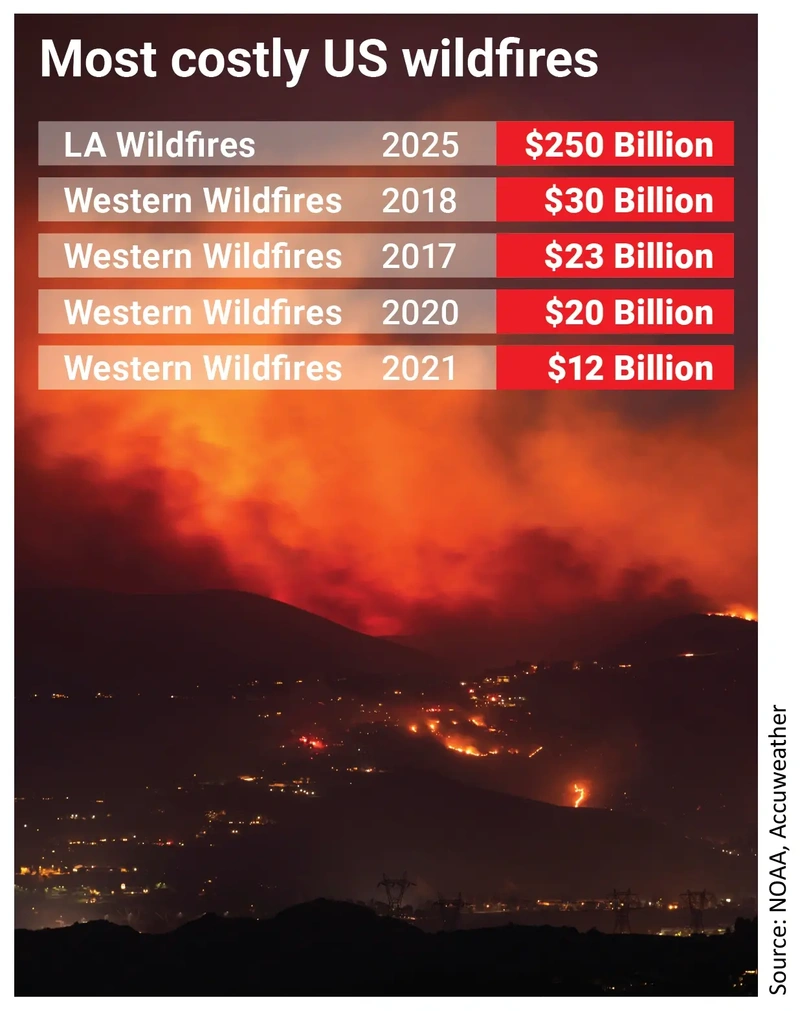Archived article
Please note that tax, investment, pension and ISA rules can change and the information and any views contained in this article may now be inaccurate.
US wildfires could rank among the most costly natural disasters in country’s history

The wildfires which seemingly came out of nowhere and have devastated large communities in the Los Angeles area, destroying more than ten thousand properties, are reckoned to have caused total damage approaching $250 billion according to forecasting service Accuweather.
That would be equal to around 4% of California’s annual GDP and would make this one of the costliest natural disasters in US history, and it will intensify the focus on insurance firms, which in most cases have ratcheted up prices for fire risk but in more extreme cases have refused to issue cover altogether.
The insurers’ defence for refusing cover is that natural disasters are growing both in size and in frequency, while the cost of rebuilding properties has soared in the last few years making it uneconomic to write policies.
Although new rules in California require insurers to underwrite a minimum percentage of policies in high-risk areas based on their overall market share across the state, that is likely to force premiums higher still.
While the fires have destroyed some of LA’s iconic neighbourhoods, it isn’t just the elevated price of houses which has lifted the cost of rebuilding – many of the structures which have been destroyed are commercial or public, with a much greater value than residential properties.
According to Jefferies’ insurance specialist Philip Kett, calculating the insured loss is complicated by the fact there are fewer examples of wildfires than other natural catastrophes, such as hurricanes, so risk is not that well modelled, but for now most estimates seem to be converging on a range between $10 billion and $20 billion, equivalent to a small hurricane.
Assuming primary insurers incur losses in line with their share of the Californian market, says Kett, most of the losses would be retained in the primary market, but there may also be some exposure through excess and surplus lines in the Lloyd’s of London market.
However, corporate loss is ‘unlikely to be material to earnings’, argues the analyst, which may explain why stocks such as Hiscox (HSX) and Lancashire (LRE) haven’t been hammered.
Hiscox reports full-year earnings on 27 February while Lancashire reports on 6 March, and we would expect both firms to comment on their potential exposure.
For Los Angeles itself, there is not just the physical damage to take into account but also the disruption to businesses including film and TV studios where work has been halted due to the fires.
The city faces a costly recovery and rebuilding effort, on top of the investment which will be needed to host the next Olympic Games in 2028.
Important information:
These articles are provided by Shares magazine which is published by AJ Bell Media, a part of AJ Bell. Shares is not written by AJ Bell.
Shares is provided for your general information and use and is not a personal recommendation to invest. It is not intended to be relied upon by you in making or not making any investment decisions. The investments referred to in these articles will not be suitable for all investors. If in doubt please seek appropriate independent financial advice.
Investors acting on the information in these articles do so at their own risk and AJ Bell Media and its staff do not accept liability for losses suffered by investors as a result of their investment decisions.
Issue contents
Editor's View
Exchange-Traded Funds
Feature
Great Ideas
News
- Anpario’s fifth full-year upgrade in a row feeds further gains
- US wildfires could rank among the most costly natural disasters in country’s history
- Greggs shares hit a 52-week low despite sales hitting £2 billion milestone
- Is another upgrade cooking at Cranswick?
- Oil price hits six-month high amid sanctions and cold weather
- Why rising bond yields are testing equity investors’ risk appetite
 magazine
magazine









